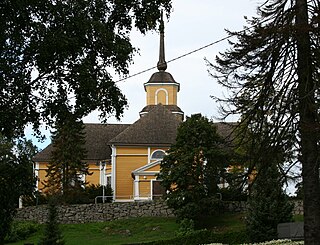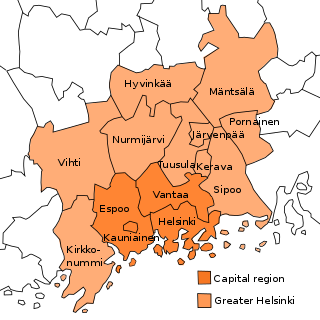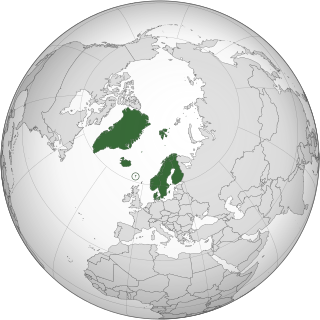
Vantaa is a city and municipality in Finland. It is part of the inner core of the Finnish Capital Region along with Helsinki, Espoo, and Kauniainen. With a population of 243,496, Vantaa is the fourth most populated city in Finland after Helsinki, Espoo and Tampere. Its administrative center is the Tikkurila district. Vantaa is bordered by Helsinki, the Finnish capital, to the south; Espoo to the southwest; Nurmijärvi to the northwest; Kerava and Tuusula to the north; and Sipoo to the east. The city encompasses 240.35 square kilometres (92.80 sq mi), of which 1.97 km2 (0.76 sq mi) is water.

Nurmijärvi is the most populated rural municipality of Finland, located 37 kilometres (23 mi) north of the capital Helsinki. The neighboring municipalities of Nurmijärvi are Espoo, Vantaa, Tuusula, Hyvinkää and Vihti, and it is part of the Greater Helsinki. The population of the municipality is 44,435 inhabitants. In recent decades, it has been one of the fastest growing municipalities in the Greater Helsinki and also in whole Finland in terms of population. The close proximity to Helsinki has led to a considerable growth of the major villages such as Klaukkala, Rajamäki and Röykkä. Klaukkala is the biggest built-up area of Nurmijärvi, which nowadays is considered a dormitory town of Helsinki. The Nurmijärvi church village (Kirkonkylä) is the administrative centre of the municipality, although the clear emphasis on population growth is in Klaukkala.

Forssa is a town and municipality of Finland. It is located almost in the centre of a triangle defined by the three largest major cities in Finland, in the Tavastia Proper region, and which is crossed by Highway 2 between Pori and Helsinki and Highway 10 between Turku and Hämeenlinna. The town has a population of 16,431 and covers an area of 253.38 square kilometres (97.83 sq mi) of which 4.61 km2 (1.78 sq mi) is water. The population density is 66.05 inhabitants per square kilometre (171.1/sq mi). Only a little part of the surface area of Forssa is water, but the river Loimijoki forms an important element in the cityscape, with the city being located at its starting point. Other notable water areas in Forssa include the lake Kaukjärvi and the lake Koijärvi, known as the birthplace of the Green League.

An urban area, built-up area or urban agglomeration is a human settlement with a high population-density and an infrastructure of built environment.

Kuusamo is a town and municipality in Finland. It is located in the Northern Ostrobothnia region. The municipality has a population of 15,124 and covers an area of 5,808.92 square kilometres (2,242.84 sq mi) of which 830.81 km2 (320.78 sq mi) is water. The population density is 3.04 inhabitants per square kilometre (7.9/sq mi).

Kärsämäki is a municipality of Finland. It is located in the province of Oulu and is part of the Northern Ostrobothnia region. The municipality has a population of 2,467 and covers an area of 700.91 square kilometres (270.62 sq mi) of which 6.06 km2 (2.34 sq mi) is water. The population density is 3.55 inhabitants per square kilometre (9.2/sq mi). Kärsämäki is a significant road junction where Highway 4 (Helsinki–Oulu–Utsjoki) and Highway 28 (Kokkola–Kajaani) intersect and where Highway 58 leading to Kangasala begins. The distance to the regional capital Oulu is 123 kilometres (76 mi).

Greater Helsinki is the metropolitan area surrounding Helsinki, the capital city of Finland. It includes the smaller Capital Region urban area.
An urban area or tätort in Sweden has a minimum of 200 inhabitants and may be a city, town or larger village. It is a purely statistical concept, not defined by any municipal or county boundaries. Larger urban areas synonymous with cities or towns for statistical purposes have a minimum of 10,000 inhabitants. The same statistical definition is also used for urban areas in the other Nordic countries.

A city proper is the geographical area contained within city limits. The term proper is not exclusive to cities; it can describe the geographical area within the boundaries of any given locality. The United Nations defines the term as "the single political jurisdiction which contains the historical city centre."

The Nordic countries are a geographical and cultural region in Northern Europe and the North Atlantic. It includes the sovereign states of Denmark, Finland, Iceland, Norway and Sweden; the autonomous territories of the Faroe Islands and Greenland; and the autonomous region of Åland.

An urban area in Finland is defined as a cluster of dwellings with at least 200 inhabitants. The Finnish term for this is a taajama. Because of the strict definition of a taajama, these areas exist both inside and outside of city and municipal borders.

The Helsinki urban area, is the largest taajama in Finland. It's located in the Uusimaa region in Finland and has about 1.23 million inhabitants as of 2019.
Tampere urban area, is the largest urban area, taajama in the Pirkanmaa region, and the second largest urban area in whole Finland after the Helsinki urban area. At the end of 2018 it had a population of 337 541 with a land area of 277.54 km2, resulting in a population density of 1 216.2 inhabitants per km2 in the urban area.












